The Navigator refers to the saint who is also known as St Brendan the Navigator, said to have discovered America. St Brendan set out on his famous voyage for the Land of Delight in the early 6th century. In 1976, Tim Severin, a British navigation scholar, constructed a replica of the vessel, said to have been used by Brendan and his fellow monks.
Prints and text about The Navigator.
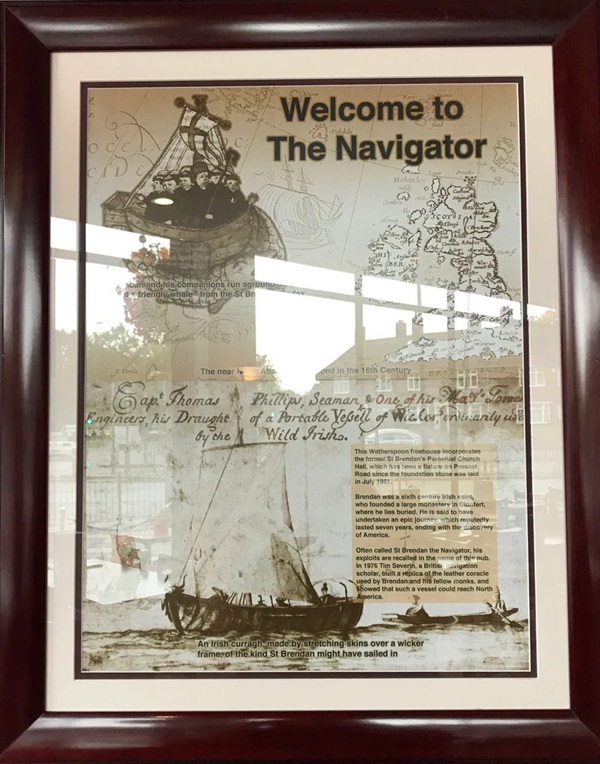
The text reads: This Wetherspoon freehouse incorporates the former St Brendan’s Parochial Church Hall, which has been a fixture on Prescot Road since the foundation store was laid in July 1961.
Brendan was a sixth century Irish saint, who founded a large monastery in Clonfert, where he lied buried. He is said to have undertaken an epic journey, which reputedly lasted seven years, ending with the discovery of America.
Often called St Brendan the Navigator, his exploits are recalled in the name of this pub. In 1976 Tim Severin, a British navigation scholar, built a replica of the leather coracle used by Brendan and his fellow monks, and showed that such a vessel could reach North America.
Prints, illustrations and text about George Stephenson’s Rocket.
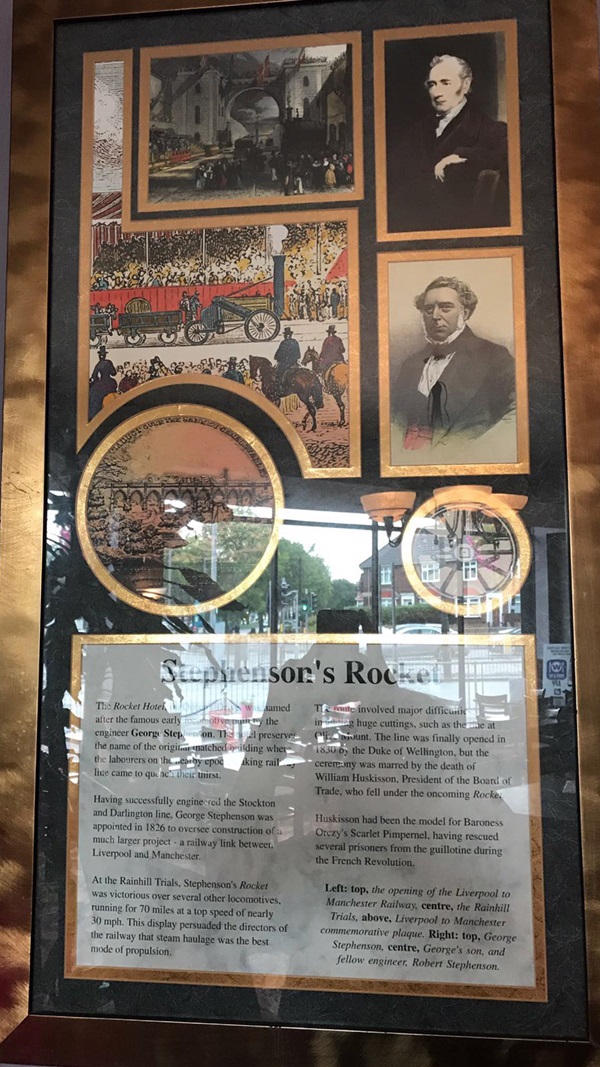
The text reads: The Rocket Hotel, on Queen’s Drive, was named after the famous early locomotive built by the engineer George Stephenson. The hotel preserves the name of the original thatched building where the labourers on the nearby epoch-making railway line came to quench their thirst.
Having successfully engineered the Stockton and Darlington line, George Stephenson was appointed in 1826 to oversee construction of a much larger project – a railway link between Liverpool and Manchester.
At the Rainhill Trials, Stephenson’s Rocket was victorious over several other locomotives, running for 70 miles at the top speed of nearly 30mph. this display persuaded the directors of the railway that steam haulage was the best mode of transport.
The route involved major difficulties, including huge cuttings, such as the one at Olive Mount. The line was finally opened in 1830 by the Duke of Wellington, but the ceremony was marred by the death of William Huskisson, President of the Board of Trade, who fell under the oncoming Rocket.
Huskisson had been the model for Baroness Orczy’s Scarlet Pimpernel, having rescued several prisoners from the guillotine during the French Revolution.
Left: top, the opening of the Liverpool to Manchester Railway, centre, the Rainhill Trials, above, Liverpool to Manchester commemorative plaque
Right: top, George Stephenson, centre, George’s son, and fellow engineer, Robert Stephenson.
Prints, photographs and text about the Co-operative Movement.
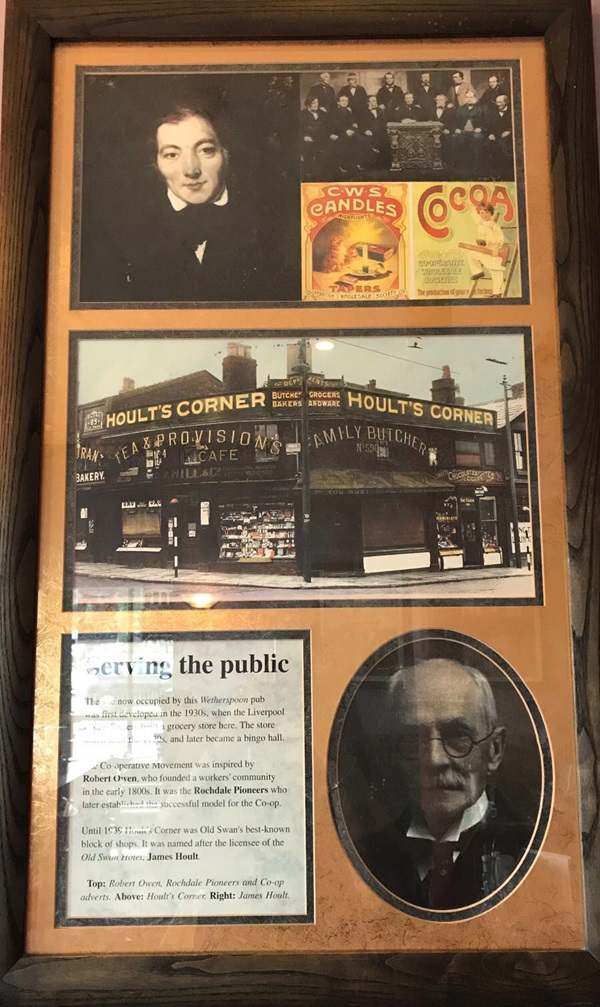
The text reads: The site now occupied by this Wetherspoon pub was first developed in the 1930s, when the Liverpool Co-op Society built a grocery store here. There store lasted until the 1970s, and later became a bingo hall.
The Co-operative Movement was inspired by Robert Owen, who founded a workers’ community in the early 1800s. It was the Rochdale Pioneers who later established the successful model for the Co-op.
Until 1939 Hoult’s Corner was Old Swan’s best-known block of shops. It was named after the licensee of the Old Swan Hotel, James Hoult.
Top: Robert Owen, Rochdale Pioneers and Co-op adverts
Above: Hoult’s Corner
Right: James Hoult.
Illustrations and text about Jeremiah Horrocks.
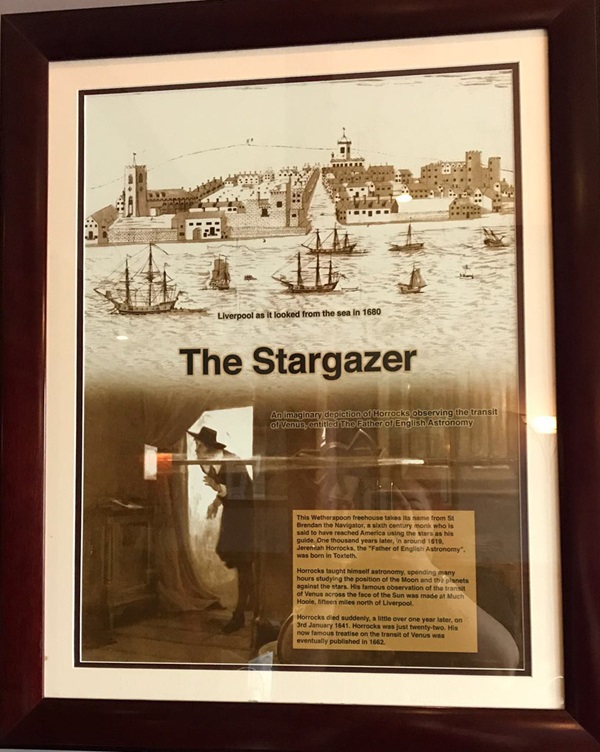
The text reads: This Wetherspoon freehouse takes its name from St Brendan the Navigator, a sixth century monk who is said to have reached America using the stars as his guide. One thousand years later, in around 1619, Jeremiah Horrocks, the “Father of English Astronomy”, was born in Toxeth.
Horrocks taught himself astronomy, spending many hours studying the position of the moon and the planets against the stars. His famous observation of the transit of Venus across the face of the sun was made at Much Hoole, fifteen miles north of Liverpool.
Horrocks died suddenly, a little over one year later, on 3rd January 1641. Horrocks was just twenty-two. His ow famous treatise on the transit of Venus was eventually published in 1662.
Illustrations and text about the Irishmen, the Norsemen and the Egyptians.
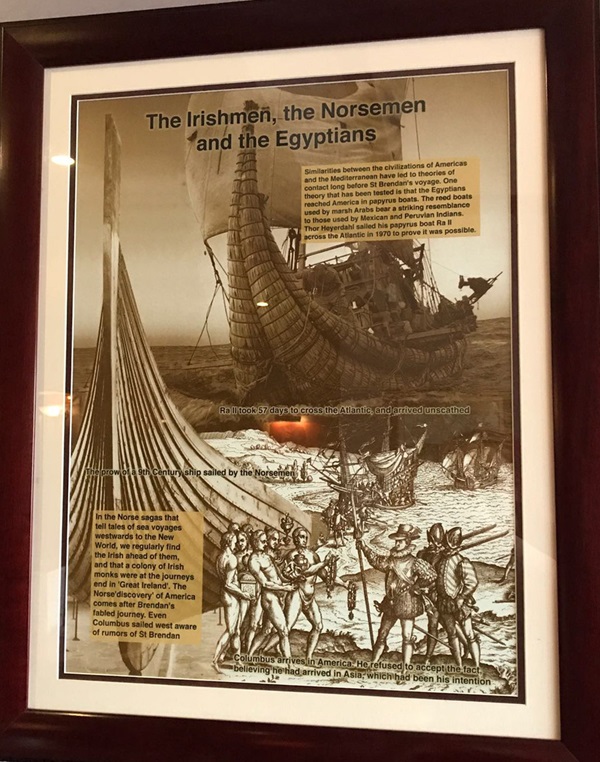
The text reads: Similarities between the civilizations of Americas and the Mediterranean have led to theories of contact long before St Brendan’s voyage. One theory that has been tested is that the Egyptians reached America in papyrus boats. The reed boats used by marsh Arabs bear a striking resemblance to those used the Mexican and Peruvian Indians. Thor Heyerdahl sailed his papyrus boat Ra II across the Atlantic in 1970 to prove it was possible.
In the Norse sagas that tell tales of sea voyages westwards to the New World, we regularly find the Irish ahead of them, and that a colony of Irish monks were at the journeys end in ‘Great Ireland’. The Norse ‘discovery’ of America comes after Brendan’s fabled journey. Even Columbus sailed west aware of rumours of St Brendan.
External photograph of the building – main entrance.
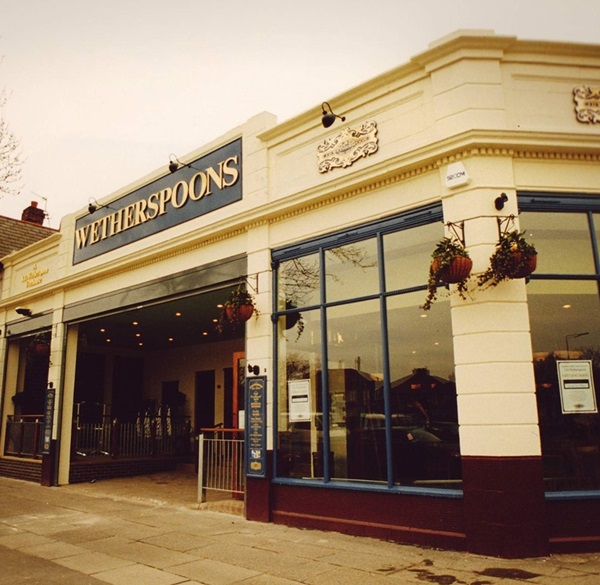
If you have information on the history of this pub, then we’d like you to share it with us. Please e-mail all information to: pubhistories@jdwetherspoon.co.uk